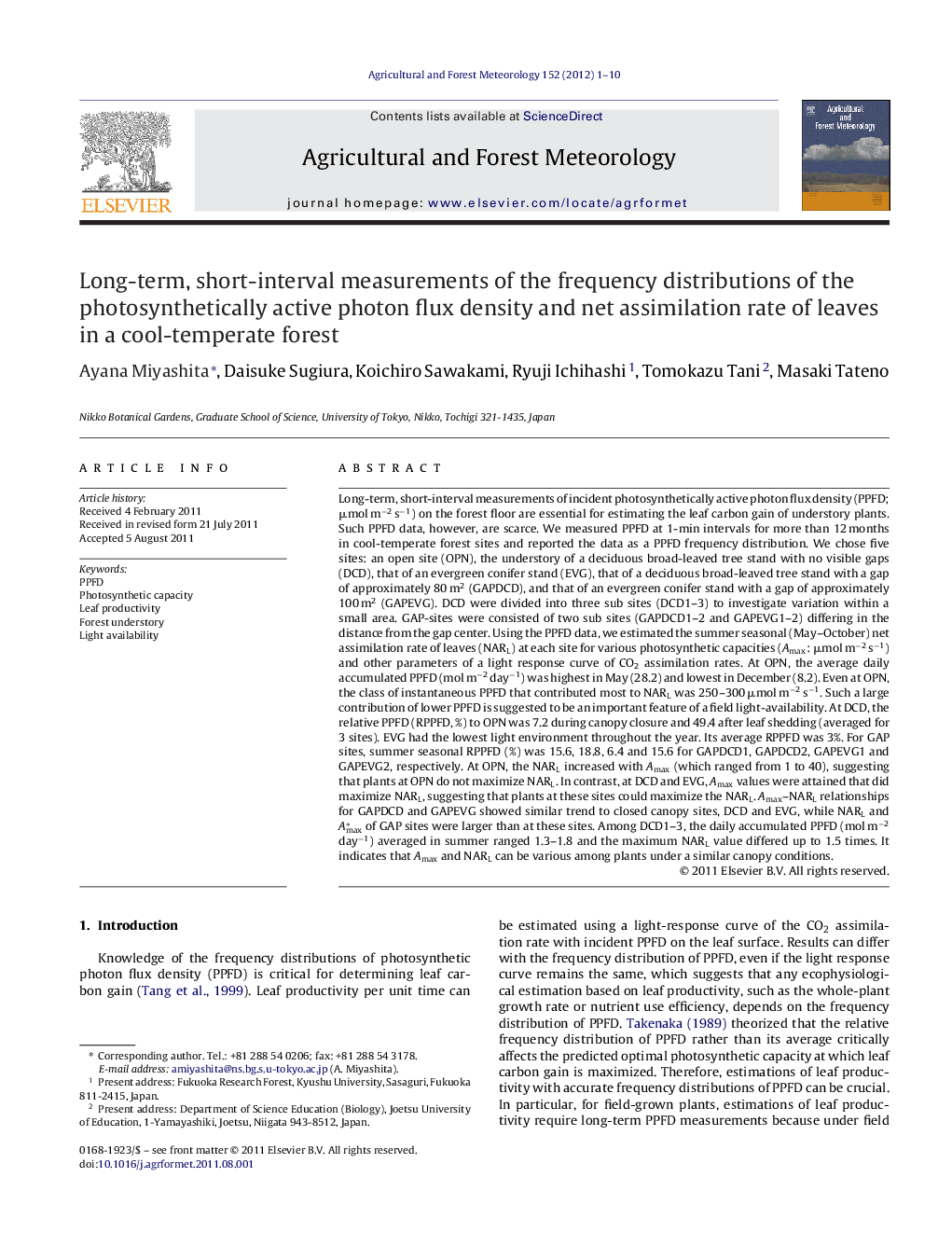| کد مقاله | کد نشریه | سال انتشار | مقاله انگلیسی | نسخه تمام متن |
|---|---|---|---|---|
| 81955 | 158364 | 2012 | 10 صفحه PDF | دانلود رایگان |

Long-term, short-interval measurements of incident photosynthetically active photon flux density (PPFD; μmol m−2 s−1) on the forest floor are essential for estimating the leaf carbon gain of understory plants. Such PPFD data, however, are scarce. We measured PPFD at 1-min intervals for more than 12 months in cool-temperate forest sites and reported the data as a PPFD frequency distribution. We chose five sites: an open site (OPN), the understory of a deciduous broad-leaved tree stand with no visible gaps (DCD), that of an evergreen conifer stand (EVG), that of a deciduous broad-leaved tree stand with a gap of approximately 80 m2 (GAPDCD), and that of an evergreen conifer stand with a gap of approximately 100 m2 (GAPEVG). DCD were divided into three sub sites (DCD1–3) to investigate variation within a small area. GAP-sites were consisted of two sub sites (GAPDCD1–2 and GAPEVG1–2) differing in the distance from the gap center. Using the PPFD data, we estimated the summer seasonal (May–October) net assimilation rate of leaves (NARL) at each site for various photosynthetic capacities (Amax: μmol m−2 s−1) and other parameters of a light response curve of CO2 assimilation rates. At OPN, the average daily accumulated PPFD (mol m−2 day−1) was highest in May (28.2) and lowest in December (8.2). Even at OPN, the class of instantaneous PPFD that contributed most to NARL was 250–300 μmol m−2 s−1. Such a large contribution of lower PPFD is suggested to be an important feature of a field light-availability. At DCD, the relative PPFD (RPPFD, %) to OPN was 7.2 during canopy closure and 49.4 after leaf shedding (averaged for 3 sites). EVG had the lowest light environment throughout the year. Its average RPPFD was 3%. For GAP sites, summer seasonal RPPFD (%) was 15.6, 18.8, 6.4 and 15.6 for GAPDCD1, GAPDCD2, GAPEVG1 and GAPEVG2, respectively. At OPN, the NARL increased with Amax (which ranged from 1 to 40), suggesting that plants at OPN do not maximize NARL. In contrast, at DCD and EVG, Amax values were attained that did maximize NARL, suggesting that plants at these sites could maximize the NARL. Amax–NARL relationships for GAPDCD and GAPEVG showed similar trend to closed canopy sites, DCD and EVG, while NARL and Amax* of GAP sites were larger than at these sites. Among DCD1–3, the daily accumulated PPFD (mol m−2 day−1) averaged in summer ranged 1.3–1.8 and the maximum NARL value differed up to 1.5 times. It indicates that Amax and NARL can be various among plants under a similar canopy conditions.
► Frequency distributions of PPFD measured every minute throughout a year was provided.
► In the high-light field site, lower PPFD was important for its quality and quantity.
► Maximum leaf net assimilation rates were predicted at low-light understory sites.
► Unsaturated leaf net assimilation rates were predicted at the high-light open site.
Journal: Agricultural and Forest Meteorology - Volume 152, 15 January 2012, Pages 1–10